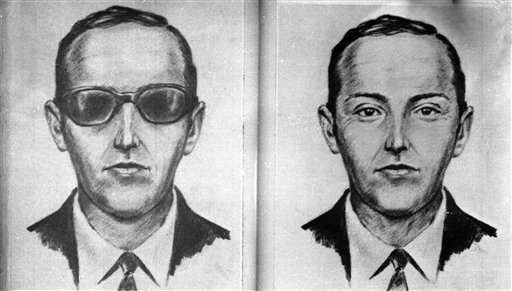LOS ANGELES (AP) — A few charred $20 bills in the forest, a bunch of unidentified fingerprints and a few witnesses’ descriptions are among the tantilizing bits of evidence left by elusive airline hijacker D.B. Cooper, who parachuted out of a Boeing 727 with $200,000 ransom in 1971 and vanished.
The mysterious Cooper became a legend for outsmarting corporate America and evading the FBI for 40 years. But now investigators are pursuing a new lead that might put the case to rest — or not.
The FBI’s Seattle office is looking into a tip from a witness who contends the hijacker died 10 years ago, Seattle FBI agent Frederick Gutt said Monoday. The witness was brought to the FBI’s attention by a retired law enforcement officer, Gutt said.
Gutt provided few details, but said the bureau considers the tip credible and its most promising current lead. Nevertheless, he said, it’s a low priority case these days.
The FBI is attempting to match fingerprints taken from belongings of the dead man to fingerprints gathered 40 years ago from the cabin of the jetliner that Cooper hijacked.
The witness was not seeking publicity or writing a book, Gutt said, and the information he offered fits into a “plausible story.”
It remains the only unsolved hijacking in history, according to FBI officials.
Even the hijacker’s real name is a mystery. A man calling himself Dan Cooper purchased a one-way ticket from Portland, Ore., to Seattle the day before Thanksgiving, 1971, at the Northwest Airlines airport counter. The initials “D.B.” came from an Oregon man questioned in the case, but cleared.
Witnesses say Cooper was in his mid-40s, between 5-10 and 6-2. He wore a black raincoat, a dark suit, a white shirt and a black necktie. He could have passed for a funeral director or a banker with his mother-of-pearl tie tack.
Once aboard the aircraft, he ordered a bourbon and water and lighted a cigarette — smoking on airliners was commonplace back then. He called over a stewardess and handed her a note, printed in all capitals: “I have a bomb in my briefcase. I will use it if necessary. I want you to sit next to me. You are being hijacked.”
By late afternoon, the plane had landed in Seattle, where it was refueled and the passengers removed. By evening, the ransom and parachutes he’d requested had been delivered and the plane took off for Reno.
At 8:13 p.m., the aircraft’s tail section sustained a sudden upward movement. Cooper had apparently opened a rear door and jumped into the Pacific Northwest forest — during a bitterly cold storm.
How could he have survived, investigators wondered.
At times, the FBI has thought it was close to solving the mystery, only to see its evidence unravel. In 2008, a parachute turned up in the forest, but investigators determined it had been manufactured after the hijacking and used in meteorological work. Some of the $20 bills Northwest paid as ransom were recovered in the forest, charred — perhaps by lightning, perhaps by a fire that Cooper built to stay warm. Did he have to use the cash as kindling to survive?
The FBI’s Gutt cautioned that the new line of investigation is one of only several leads the FBI is following, and that the case is no longer viewed as a top priority. People’s memories are getting foggy. Witnesses are dying. Even if Cooper survived the jump, he could be dead too. And there are more important matters.
“I don’t want to make it sound like this is a fast-moving, high-priority matter,” Gutt said. “We have missing children, human trafficking and gangs. There are more pressing problems.”
But the Cooper case has garnered a lion’s share of publicity over the years. FBI agent Ralph Himmelsbach, who spent eight years investigating it before he retired, said in an interview Monday that he had received a dozen calls on the new developments.
Himmelsbach was working in the FBI’s Portland office on the day of the hijacking. He tried to follow the airliner in an Army helicopter as it flew south toward Reno, Nev., but stopped chasing it after 40 minutes. He spent the rest of his career looking for Cooper, investigating dozens, if not hundreds, of tips that went nowhere.
Himmelsbach’s hunch is that Cooper’s bones are lying at the same spot where he landed 40 years ago. Even decades later, Himmelsbach, 85 years old and recovering from recent back surgery, gets tips that he turns over the FBI.
“It has run into nothing,” he said.
Himmelsbach said he understands how the long-running case has become part of an American subculture that roots for the underdog.
“Here is a little guy who all by himself hijacked an airliner and got away with $200,000 of a big corporation’s money, tweaked Uncle Sam’s nose and has gotten away with it,” he said. “I don’t look at it that way. He was a sleazy, rotten criminal, and if I ever see him face to face, I am going to say, ‘You are under arrest.’ “



